Paul Mounet (1847–1922), born Jean-Paul Sully, was a legendary French actor of the Comédie Française. Around 1910, he acted in various Film d'Art productions, but little was known about these early silent films. For EFSP, Ivo Blom reconstructed which films Mounet appeared in.

French postcard. Photo: Boyer, Paris. Caption: Paul Mounet de la Comédie-Française.
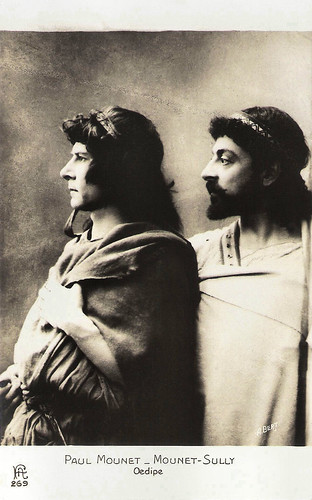
French postcard by F.A., printed by A. Christensen, imp, Rueil, no. 269. Photo: A. Bert. Paul Mounet and Jean Mounet-Sully in the stage play 'Oedipe Roi' (Oedipus Rex) by Sophocles at the Comédie-Française in 1892.

French collector card in the Collection Félix Potin, series 1 (c. 1900).

French postcard by A.N. [Noyer], Paris, no. 125. Photo: Nadar, Paris. Caption: Paul Mounet, artiste dramatique. Paul Mounet as the title character in William Shakespeare's play 'Macbeth'. On stage, Mounet played the part first in October 1884 at the Théâtre de l'Odéon in Paris. In 1909, Mounet played the Shakespearean title character opposite Jeanne Delvair as Lady Macbeth in the Film d'Art production Macbeth (possibly André Calmettes, 1909). In 1914, Mounet reprised the part on stage in a reworking by Jean Richepin, but the photo on this card seems to refer to the earlier version.
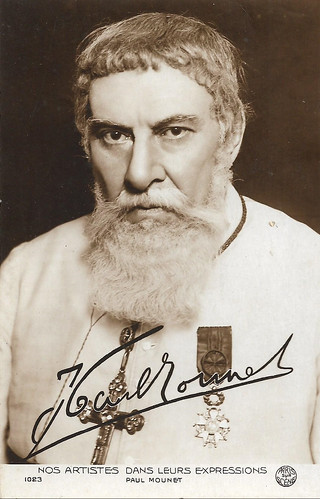
French postcard in the Nos artistes dans leurs expressions series, no. 1023. Photo: Paris sur scène. Paul Monet in Par la vérité / By the truth (Maurice de Féraudy, Gaston Leprieur, 1917).
Paul Mounet was born in Bergerac, Dordogne, in 1847. He was the younger brother of actor Jean Mounet-Sully, aka Mounet-Sully.
Paul studied to become a medical doctor before his career in acting. He made his stage debut in 1880 in Paris at the Odéon's production of 'Horace'. All through the 1880s, he acted at the Odeon. It was in 1889 that he first played at the Comédie-Française, of which he became a sociétaire two years later. Mounet garnered acclaim for his roles in 'Les Érinnyes', 'L'Arlésienne', 'Severo Torelli', 'Othello', 'Patrie', 'Hamlet', and 'Œdipe Roi'.
Between 1908 and 1917, Paul Mounet appeared in several films, mostly Film d'Art-like productions at the companies Le Film d'Art, Pathé and Eclipse, and often based on previous stage successes by Mounet.
However, IMDb makes quite a few errors in Mounet's filmography. Either he or André Calmettes may have acted as Scarpia in a version of La Tosca (Charles Le Bargy, André Calmettes, 1908) with Sarah Bernhardt, but this version had only a very short release in December 1908, while Bernhardt had even forbidden the showing of the film.
In January 1909, a new version was made by Le Film d'Art with Cécile Sorel in the lead and Charles Le Bargy as Scarpia, so not Mounet. Neither was he in Rigoletto, the American title for Le roi 's amuse (Albert Capellani, 1909). Also, it was NOT Paul Mounet but his brother Mounet-Sully who acted in Le baiser de Judas (André Calmettes, Armand Bour, 1909).

French postcard. Paul Mounet and Mounet-Sully in 'Ruy Blas' by Victor Hugo, Comédie Française.

French postcard in the Collection Artistique du Vin Désiles. Photo: Paul Berger, Paris. Caption: Vin Désiles is a useful and pleasant travel companion - before or after the meal.

French postcard by FA, no. 57. Photo: Félix. Caption: Paul Mounet, Comédie-Française.
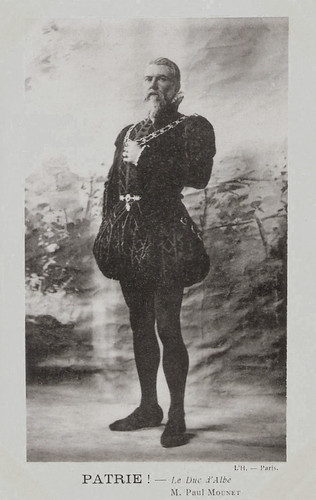
French postcard. Photo: L'H, Paris. Paul Mounet as Le Duc d'Albe in 'Patrie!' (1901) by Victorien Sardou and presented by the Comédie-Française.
Paul Mounet DID play Ulysses opposite Julia Bartet as Penelope and Albert Lambert as Antinuous in Le retour d'Ulysse / The Return of Ulysses (André Calmettes, Charles Le Bargy, 1909), and he played the Shakespearian title character Macbeth opposite Jeanne Delvair as Lady Macbeth in Macbeth (André Calmettes, 1909). In 1884 Mounet had already played Macbeth at the Théâtre de l'Odéon, and in 1914 he would play the role again, now at the Comédie-Française.
Released in 1910 (and not 1909 as IMDb writes) were Mounet's films Rival de son père (André Calmettes, 1910) based on Schiller's 'Don Carlos', also with Emile Dehelly and Julia Bartet, and Louis XI (André Calmettes, 1910) with again Dehelly and Bartet, though the latter may have been a mix up with L'Héritière / The Heiress. In 1910 indeed Mouniet had the lead of Louis XI in L'Héritière / The Heiress (Henri Pouctal or André Calmettes, 1910), also with Henri Rollan as The Duke of Nemours and Mlle Gilman as Marie of Burgundy, daughter of Charles the Bold and heiress of a vast territory, which the French King Louis XI would like to conquer.
In 1912 he acted in his last Film d'Art production, Les Jacobites / The Jacobites, for whom the director is unknown, and in which Jeanne Provost and Emile Dehelly were Mounet's co-actors. He had already played the role on stage in 1885. Inspired by the Film d'Art productions, the new company Eclipse (1906) started to make historical films and stage adaptations as well, and launched in 1912 La légende d'Oedipe / The Legend of Oedipus (released December 1913), directed by Gaston Roudès. Sophocles' tragedy had already been brought to the screen by André Calmettes for Le Film d'Art in 1910, with Mounet's brother Mounet-Sully in the lead.
Jean Mounet-Sully had performed the play from 1901 and it had become his 'pièce de resistance'. His brother Paul had played the blind prophet and clairvoyant Tiresias in the same play. In 1912 Eclipse asked Mounet-Sully to play his star role gain, and asked his brother to play Tiresias again. Jeanne Delvair played Jocaste, Jean Hervé young Oedipus, and Louis Delaunay Creon. Jean Mounet-Sully scripted the film.His last fiction film part, Paul Mounet played as the Reverend Father Aurégan in the courtroom drama Par la vérité / By the Truth (Maurice de Féraudy, Gaston Leprieur, 1917), based on Ernest Daudet's story, and starring Marcelle Géniat. In court, without betraying his vow of confidentiality, the priest makes clear the supposed culprit of murder is innocent.
Paul Mounet served as a professor at the Paris Conservatoire, teaching, among others, Pierre Fresnay, Valentine Tessier, Hélène Dieudonné, Léonce Perret, Daniel Mendaille, Françoise Rosay, and Marie Ventura. He became a Chevalier in the Legion of Honour. Mounet died of heart disease in 1922. In 1880 he had married the opera singer Madeleine Andrée Barbot (1852-1923), who also knew a brief career as tragedy actress in the 1880s, before returning to opera.

French postcard. Paul Mounet as Tiresias in 'Oedipe Roi' by Sophocles at the Comédie Française.
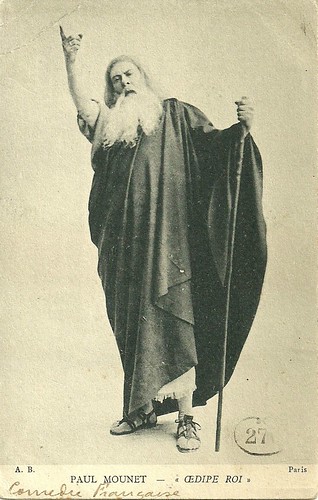
French postcard by A.B., Paris. Paul Mounet in the play 'Oedipe Roi' by Sophocles.

French still. Photo: Eclipse.Oedipus (Jean Mounet-Sully) and Tiresias (Paul Mounet) in the lost film La légende d'Oedipe / Oedipe-roi/ Oedipus Rex (Gaston Roudès, 1912). Mounet-Sully already acted around 1908 or 1909 in an earlier version, filmed by André Calmettes for Film d'Art, entitled Oedipe-roi, of which less than a minute survives. It can be viewed on a dvd attached to the publication' De la scène à la pellicule. Théâtre, musique et cinéma autour de 1900' (2021), edited by Rémy Campos, Alain Carou and Aurélien Poidevin.
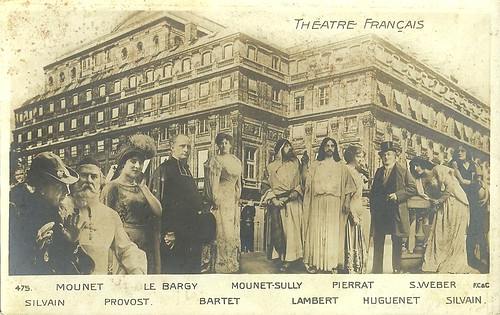
French postcard by F.C. & Cie., Paris, no. 475. This cards shows a 1920s photomontage of the actors of the Comédie Française, partly dressed in the costumes of their most famous plays. In the back, the Théàtre Français, home of the Comédie. From left to right: (Eugène) Silvain / Sylvain, Paul Mounet, Jeanne Provost, Charles Le Bargy, Julia Bartet, Jean Mounet-Sully, Albert Lambert, Pierrat, Huguenet, Ségond-Weber, Louise Silvain. Almost all of these actors also had a film career, either in the Film d'Art films of the early 1910s, or (also) at later stages.

French postcard by F.C. & Cie, no. 52. Photo: P. Boyer. Caption: Theatre Francais. Mounet's costume seems to refer to his last film, Par la vérité / By the Truth (1917).
NB The film Rival de son père (1909) is not mentioned at the Seydoux Pathé site, but is mentioned in the Le Film d'Art filmography in the journal 1895, as well as on the Ciné-Ressources website. Neither is the film Les Jacobites (1912) mentioned at the Pathé website, but is part of the Ciné-Ressources website.
Sources: Ciné-Ressources (French), Fondation Seydoux Pathé (French), 1895 (French), Wikipedia and IMDb.
This post was last updated on 14 November 2025.

French postcard. Photo: Boyer, Paris. Caption: Paul Mounet de la Comédie-Française.

French postcard by F.A., printed by A. Christensen, imp, Rueil, no. 269. Photo: A. Bert. Paul Mounet and Jean Mounet-Sully in the stage play 'Oedipe Roi' (Oedipus Rex) by Sophocles at the Comédie-Française in 1892.

French collector card in the Collection Félix Potin, series 1 (c. 1900).

French postcard by A.N. [Noyer], Paris, no. 125. Photo: Nadar, Paris. Caption: Paul Mounet, artiste dramatique. Paul Mounet as the title character in William Shakespeare's play 'Macbeth'. On stage, Mounet played the part first in October 1884 at the Théâtre de l'Odéon in Paris. In 1909, Mounet played the Shakespearean title character opposite Jeanne Delvair as Lady Macbeth in the Film d'Art production Macbeth (possibly André Calmettes, 1909). In 1914, Mounet reprised the part on stage in a reworking by Jean Richepin, but the photo on this card seems to refer to the earlier version.

French postcard in the Nos artistes dans leurs expressions series, no. 1023. Photo: Paris sur scène. Paul Monet in Par la vérité / By the truth (Maurice de Féraudy, Gaston Leprieur, 1917).
Correcting a few errors
Paul Mounet was born in Bergerac, Dordogne, in 1847. He was the younger brother of actor Jean Mounet-Sully, aka Mounet-Sully.
Paul studied to become a medical doctor before his career in acting. He made his stage debut in 1880 in Paris at the Odéon's production of 'Horace'. All through the 1880s, he acted at the Odeon. It was in 1889 that he first played at the Comédie-Française, of which he became a sociétaire two years later. Mounet garnered acclaim for his roles in 'Les Érinnyes', 'L'Arlésienne', 'Severo Torelli', 'Othello', 'Patrie', 'Hamlet', and 'Œdipe Roi'.
Between 1908 and 1917, Paul Mounet appeared in several films, mostly Film d'Art-like productions at the companies Le Film d'Art, Pathé and Eclipse, and often based on previous stage successes by Mounet.
However, IMDb makes quite a few errors in Mounet's filmography. Either he or André Calmettes may have acted as Scarpia in a version of La Tosca (Charles Le Bargy, André Calmettes, 1908) with Sarah Bernhardt, but this version had only a very short release in December 1908, while Bernhardt had even forbidden the showing of the film.
In January 1909, a new version was made by Le Film d'Art with Cécile Sorel in the lead and Charles Le Bargy as Scarpia, so not Mounet. Neither was he in Rigoletto, the American title for Le roi 's amuse (Albert Capellani, 1909). Also, it was NOT Paul Mounet but his brother Mounet-Sully who acted in Le baiser de Judas (André Calmettes, Armand Bour, 1909).

French postcard. Paul Mounet and Mounet-Sully in 'Ruy Blas' by Victor Hugo, Comédie Française.

French postcard in the Collection Artistique du Vin Désiles. Photo: Paul Berger, Paris. Caption: Vin Désiles is a useful and pleasant travel companion - before or after the meal.

French postcard by FA, no. 57. Photo: Félix. Caption: Paul Mounet, Comédie-Française.

French postcard. Photo: L'H, Paris. Paul Mounet as Le Duc d'Albe in 'Patrie!' (1901) by Victorien Sardou and presented by the Comédie-Française.
Historical films and stage adaptations
Paul Mounet DID play Ulysses opposite Julia Bartet as Penelope and Albert Lambert as Antinuous in Le retour d'Ulysse / The Return of Ulysses (André Calmettes, Charles Le Bargy, 1909), and he played the Shakespearian title character Macbeth opposite Jeanne Delvair as Lady Macbeth in Macbeth (André Calmettes, 1909). In 1884 Mounet had already played Macbeth at the Théâtre de l'Odéon, and in 1914 he would play the role again, now at the Comédie-Française.
Released in 1910 (and not 1909 as IMDb writes) were Mounet's films Rival de son père (André Calmettes, 1910) based on Schiller's 'Don Carlos', also with Emile Dehelly and Julia Bartet, and Louis XI (André Calmettes, 1910) with again Dehelly and Bartet, though the latter may have been a mix up with L'Héritière / The Heiress. In 1910 indeed Mouniet had the lead of Louis XI in L'Héritière / The Heiress (Henri Pouctal or André Calmettes, 1910), also with Henri Rollan as The Duke of Nemours and Mlle Gilman as Marie of Burgundy, daughter of Charles the Bold and heiress of a vast territory, which the French King Louis XI would like to conquer.
In 1912 he acted in his last Film d'Art production, Les Jacobites / The Jacobites, for whom the director is unknown, and in which Jeanne Provost and Emile Dehelly were Mounet's co-actors. He had already played the role on stage in 1885. Inspired by the Film d'Art productions, the new company Eclipse (1906) started to make historical films and stage adaptations as well, and launched in 1912 La légende d'Oedipe / The Legend of Oedipus (released December 1913), directed by Gaston Roudès. Sophocles' tragedy had already been brought to the screen by André Calmettes for Le Film d'Art in 1910, with Mounet's brother Mounet-Sully in the lead.
Jean Mounet-Sully had performed the play from 1901 and it had become his 'pièce de resistance'. His brother Paul had played the blind prophet and clairvoyant Tiresias in the same play. In 1912 Eclipse asked Mounet-Sully to play his star role gain, and asked his brother to play Tiresias again. Jeanne Delvair played Jocaste, Jean Hervé young Oedipus, and Louis Delaunay Creon. Jean Mounet-Sully scripted the film.His last fiction film part, Paul Mounet played as the Reverend Father Aurégan in the courtroom drama Par la vérité / By the Truth (Maurice de Féraudy, Gaston Leprieur, 1917), based on Ernest Daudet's story, and starring Marcelle Géniat. In court, without betraying his vow of confidentiality, the priest makes clear the supposed culprit of murder is innocent.
Paul Mounet served as a professor at the Paris Conservatoire, teaching, among others, Pierre Fresnay, Valentine Tessier, Hélène Dieudonné, Léonce Perret, Daniel Mendaille, Françoise Rosay, and Marie Ventura. He became a Chevalier in the Legion of Honour. Mounet died of heart disease in 1922. In 1880 he had married the opera singer Madeleine Andrée Barbot (1852-1923), who also knew a brief career as tragedy actress in the 1880s, before returning to opera.

French postcard. Paul Mounet as Tiresias in 'Oedipe Roi' by Sophocles at the Comédie Française.

French postcard by A.B., Paris. Paul Mounet in the play 'Oedipe Roi' by Sophocles.

French still. Photo: Eclipse.Oedipus (Jean Mounet-Sully) and Tiresias (Paul Mounet) in the lost film La légende d'Oedipe / Oedipe-roi/ Oedipus Rex (Gaston Roudès, 1912). Mounet-Sully already acted around 1908 or 1909 in an earlier version, filmed by André Calmettes for Film d'Art, entitled Oedipe-roi, of which less than a minute survives. It can be viewed on a dvd attached to the publication' De la scène à la pellicule. Théâtre, musique et cinéma autour de 1900' (2021), edited by Rémy Campos, Alain Carou and Aurélien Poidevin.

French postcard by F.C. & Cie., Paris, no. 475. This cards shows a 1920s photomontage of the actors of the Comédie Française, partly dressed in the costumes of their most famous plays. In the back, the Théàtre Français, home of the Comédie. From left to right: (Eugène) Silvain / Sylvain, Paul Mounet, Jeanne Provost, Charles Le Bargy, Julia Bartet, Jean Mounet-Sully, Albert Lambert, Pierrat, Huguenet, Ségond-Weber, Louise Silvain. Almost all of these actors also had a film career, either in the Film d'Art films of the early 1910s, or (also) at later stages.

French postcard by F.C. & Cie, no. 52. Photo: P. Boyer. Caption: Theatre Francais. Mounet's costume seems to refer to his last film, Par la vérité / By the Truth (1917).
NB The film Rival de son père (1909) is not mentioned at the Seydoux Pathé site, but is mentioned in the Le Film d'Art filmography in the journal 1895, as well as on the Ciné-Ressources website. Neither is the film Les Jacobites (1912) mentioned at the Pathé website, but is part of the Ciné-Ressources website.
Sources: Ciné-Ressources (French), Fondation Seydoux Pathé (French), 1895 (French), Wikipedia and IMDb.
This post was last updated on 14 November 2025.
No comments:
Post a Comment